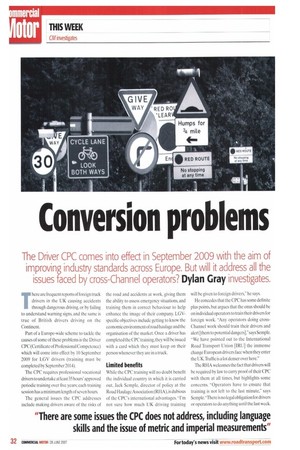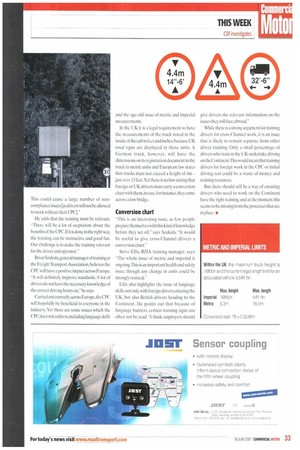Conversion problems
Page 32

Page 33

If you've noticed an error in this article please click here to report it so we can fix it.
The Driver CPC comes into effect in September 2009 with the aim of improving industry standards across Europe. But will it address all the
issues faced by cross-Channel operators? Dylan Gray investigates.
There are frequent reports of foreign truck drivers in the UK causing accidents through dangerous driving, or by failing to understand warning signs, and the same is true of British drivers driving on the Continent.
Part of a Europe-wide scheme to tackle the causes of some of these problems is the Driver CPC (Certificate of Professional Competence) which will come into effect by 10 September 2009 for LGV drivers (training must be completed by September 2014).
The CPC requires professional vocational drivers to undertake at least 35 hours' approved periodic training over five years; each training session has a minimum length of seven hours.
The general issues the CPC addresses include making drivers aware of the risks of the road and accidents at work, giving them the ability to assess emergency situations, and training them in correct behaviour to help enhance the image of their company. LGVspecific objectives include getting to know the economic environment of road haulage and the organisation of the market. Once a driver has completed the CPC training,they will be issued with a card which they must keep on their person whenever they are in a truck.
Limited benefits
While the CPC training will no doubt benefit the individual country in which it is carried out, Jack Semple, director of policy at the Road Haulage Association (RHA), is dubious of the CPC's international advantages. "I'm not sure how much UK driving training will be given to foreign drivers," he says.
He concedes that the CPC has some definite plus points, but argues that the onus should be on individual operators to train their drivers for foreign work. "Any operators doing crossChannel work should train their drivers and alert [them to potential dangers]," says Semple. We have pointed out to the International Road Transport Union [IRU] the immense change European drivers face when they enter the UK.Traffic is a lot denser over here."
The RHA welcomes the fact that drivers will be required by law to carry proof of their CPC with them at all times, but highlights some concerns. "Operators have to ensure that training is not left to the last minute," says Semple."There is no legal obligation for drivers or operators to do anything until the last week. This could cause a large number of noncompliance issues [as drivers will not be allowed to work without their CPC]."
He adds that the training must be relevant. "There will be a lot of scepticism about the benefits of the CPC. If it is done in he right way, the training can be instructive and good fun. Our challenge is to make the training relevant for the driver and operator."
Brian Szukala, general manager of trainin at the Freight Transport Association, believes the CPC will have a positive impact across Europe. It will definitely improve standards. A lot of drivers do not have the necessary knowledge of the correct driving hours etc," he says.
Carried out correctly across Europe, the CPC will hopefully be beneficial to everyone in the industry. Yet there are some issues which the CPC does not address,including language skills and the age-old issue of metric and imperial measurements.
In the UK it is a legal requirement to have the measurements of the truck noted in the inside of the cab in feet and inches, because UK road signs are displayed in those units. A German truck, however, will have the dimensions on its registration document in the truck in metric units and European law states that trucks must not exceed a height of 4m — just over 13 feet. Yet there is no law stating that foreign or UK drivers must carry a conversion chart with them, in case, for instance, they come across a low bridge.
Conversion chart
"This is an interesting issue, as few people prepare themselves with this kind of knowledge before they set off." says Szukala. "It would be useful to give cross-Channel drivers a conversion chart."
Steve Ellis, RHA training manager, says: "The whole issue of metric and imperial is ongoing. This is an important health and safety issue. though any change in units could be strongly resisted."
Ellis also highlights the issue of language skills.not only with foreign drivers entering the UK, but also British drivers heading to the Continent. He points out that because of language barriers, certain warning signs can often not be read, "I think employers should give drivers the relevant information on the issues they will face abroad."
While there is a strong argument for training drivers for cross-Channel work, it is an issue that is likely to remain separate from other driver training. Only a small percentage of drivers who train in the UK undertake driving on the Continent...This would mean that training drivers for foreign work in the CPC or initial driving test could be a waste of money and training resources.
But there should still be a way of ensuring drivers who need to work on the Continent have the right training, and at the moment this seems to be missing from the processes that are in place. •






























































































































































































